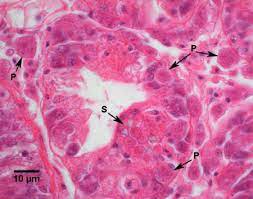
Haplosporidium nelsoni (Haskin, Stauber and Mackin 1966, MSX, 'Multinucleate Spheres of X'; Delaware Bay Disease, is a microbial parasite of oysters. Taxonomy of the Haplosporidians has varied in recent decades. They were historically regarded as protozoans, but is currently placed in the kingdom Chromista, phylum Sercozoa (WoRMS Editorial Board 2023). In oyster tissues, H. nelsoni appears as plasmodia (masses of merged cells) 4 to 100 µm in diameter (P in photo), and as spores (S in photo). [Photo of infected Eastern Oyster digestive gland from Fisheries and Oceans Canada 2018] Sporulation is rare in adult oysters, but common in oyster spat . The complete life cycle is unknown, but the spores are believed to germinate in an unknown intermediate host,. MSX disease in the Eastern Oyster (Crassostrea virginica first appeared in Delaware Bay in 1957 and in Chesapeake Bay in 1959. There is evidence the disease came into the US with infected Pacific Oysters (Magallana =Crassostrea gigas) imported from Japan. MSX is a haplosporidian parasite of the Pacific Oyster in its native range (Asia-Pacific). Recent immunological and genetic comparisons between MXS in Korea and Chesapeake Bay found the two to be nearly identical structurally and in immunological response. Between 1930 and 1970 there were many plantings of Pacific Oysters on the East Coast from Maine to North Carolina. None of these introductions resulted in established populations of the oyster, but the appearance of MSX in 1957 may have been an unintended result of these introductions. But shipping may also have played a role. Oysters have been seen in hull fouling and spores have been collected in ballast water. The MSX parasite has only minor effects on its original host, Magallana gigas.
MSX disease has had a devastating impact on the native Eastern Oyster and caused massive die-offs, and is at least partially responsible for decline in oyster harvest between 1957 and 1970. MSX disease appeared in Delaware Bay in 1957 and in Chesapeake Bay in 1959. There is evidence the disease came into the US with infected Pacific Oysters (M. gigas) imported from Japan. MSX is a haplosporidian parasite of the Pacific Oyster in its native range (Asia) and r Between 1930 and 1970 there were several unofficial plantings of Pacific Oysters in New Jersey, Maryland, and Delaware. None of these introductions resulted in established populations of the oyster, but the appearance of MSX in 1957 may have been an unintended result of these introductions. But shipping may also have played a role. Oysters have been seen in hull fouling and spores have been collected in ballast water. The disease has had a devastating impact on the native Eastern Oyster and caused massive die-offs, and is at least partially responsible for decline in oyster harvest between 1957 and 1970. The parasite has been found in coastal waters from Nova Scotia to Venezuela. Mortality has been most severe in Delaware and Chesapeake Bays, with lesser outbreaks in Nova Scotia and Long Island Sound. This parasite has also been detected in Pacific Oysters in California, Ireland, and France, but usually in small numbers, with no sign of disease. The MSX parasite is favored by temperatures of 5-20“C and salinities above 20 PSU. At temperatures above 20* C, resistant oysters can overcome the parasite. In its initial outbreaks in Chesapeake and Delaware Bays, mortality approached 90%. High oyster mortality, especially in more saline Virginia waters, prompted attempts to introduce an exotic Asian Oyster, (Magallana (\= Crassostrea ariakensis, Suminoe Oyster), thought to be more disease resistant. https://invasions.si.edu/nemesis/secret_squirrel/species_summary/-199. Sterile triploids of M. ariakensis were widely planted, but showed higher mortality than expected, as well as risks of uncontrolled reproduction.. In 2009, the US Army Corps of Engineers decided against the introduction of the exotic oyster, and instead encourage restoration of the native Eastern Oyster. Restoration efforts include establishment of oysters sanctuaries, planting of oyster shell, encouraging aquaculture, including rearing of sterile triploid Eastern Oysters. Haplosporidium nelsoni. has coexisted with the other major oyster disease, Perkinsus marinus (Dermo), probably native to the southeastern US and southern Chesapeake Bay, but spreading northward with oyster transplants and climate change. In Chesapeake Bay, the two diseases can interact in complex ways. In recent decades, resistance to both diseases has developed in Chesapeake and Delaware Bay., permitting a modest recovery, with ongoing restoration efforts.